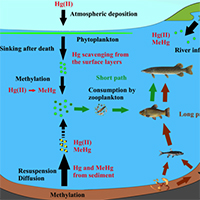Mercury methylation in oxic aquatic macro-environments: a review

Accepted: 27 February 2021
HTML: 106
All claims expressed in this article are solely those of the authors and do not necessarily represent those of their affiliated organizations, or those of the publisher, the editors and the reviewers. Any product that may be evaluated in this article or claim that may be made by its manufacturer is not guaranteed or endorsed by the publisher.
Authors
Mercury methylation in aquatic environments is a key process that incorporates this neurotoxin into the food chain and ultimately the human diet. Mercury methylation is considered to be essentially biotic and mainly driven by sulfate-reducing bacteria present in the bottom sediments in aquatic systems. However, in recent decades, many researchers have shown that this methylation also occurs in oxic layers in conjunction with a high content of particulate organic matter and localized depletion of dissolved oxygen. The goals of this review are to summarize our current understanding of Hg methylation in water columns of both marine and freshwater environments, as well as to highlight knowledge gaps and future research needs. Most of the literature showed that suspended particles (known as marine and lake snow) could be the microenvironment in which Hg methylation could occur across oxic water columns, because they have been recognized as a site of organic matter mineralization and as presenting oxygen gradients around and inside them. To date, the majority of these studies concern marine environments, highlighting the need for more studies in freshwater environments, particularly lacustrine systems. Investigating this new methylmercury production environment is essential for a better understanding of methylmercury incorporation into the trophic chain. In this review, we also propose a model which attempts to highlight the relative importance of a MeHg epilimnetic path over a MeHg benthic-hypolimnetic path, especially in deep lakes. We believe that this model could help to better focus future scientific efforts in limnic environments regarding the MeHg cycle.
Edited by
Diego Fontaneto, CNR-IRSA, Verbania, ItalyHow to Cite

This work is licensed under a Creative Commons Attribution-NonCommercial 4.0 International License.
Similar Articles
- Renato BAUDO, Biological monitoring of aquatic ecosystems in Italy , Journal of Limnology: Vol. 60 No. s1 (2001): Scientific and legal aspects of biological monitoring in freshwater
- Hiroshi Kagoshima, Satoshi Imura, Atsushi C. Suzuki, Molecular and morphological analysis of an Antarctic tardigrade, Acutuncus antarcticus , Journal of Limnology: Vol. 72 No. s1 (2013): 12th International Symposium on Tardigrada
- Pietro VOLTA, Niels JEPSEN, The recent invasion of Rutilus rutilus (L.) (Pisces: Cyprinidae) in a large South- Alpine lake: Lago Maggiore , Journal of Limnology: Vol. 67 No. 2 (2008)
- Juan Manuel MEDINA-SÁNCHEZ, Manuel VILLAR-ARGAIZ, Pedro SÁNCHEZ-CASTILLO, Luis CRUZ-PIZARRO, Presentación CARRILLO, Structure changes in a planktonic food web: biotic and abiotic controls , Journal of Limnology: Vol. 58 No. 2 (1999)
- Liisa NEVALAINEN, Tomi P. LUOTO, Suzanne LEVINE, Marina MANCA, Paleolimnological evidence for increased sexual reproduction in chydorids (Chydoridae, Cladocera) under environmental stress , Journal of Limnology: Vol. 70 No. 2 (2011)
- Nadezhda M. Yavorskaya, Marina A. Makarchenko, Oksana V. Orel, Eugenyi A. Makarchenko, An updated checklist of Chironomidae (Diptera) from the Amur River basin (Russian Far East) , Journal of Limnology: Vol. 77 No. s1 (2018): Recent advances in the study of Chironomidae: An overview
- Monika Tarkowska-Kukuryk, Wojciech Pęczuła, Tomasz Mieczan, Grazing affects periphytic algal biomass in the periphyton-macrophyte relationship independently of the substrate type and nutrient status , Journal of Limnology: Vol. 79 No. 2 (2020)
- Alessandra PUGNETTI, Roberta BETTINETTI, Biomass and species structure of the phytoplankton of an high mountain lake (Lake Paione Superiore, Central Alps, Italy) , Journal of Limnology: Vol. 58 No. 2 (1999)
- Nicoletta RICCARDI, Gianluigi GIUSSANI, Fiorenza MARGARITORA, Bruno COUCHAUD, Population dynamics of the pioneer population of Daphnia parvula, Fordyce during the invasion of Lake Candia (Northern Italy) , Journal of Limnology: Vol. 63 No. 1 (2004)
- Sungsoo Yoon, GoWoon Kim, Ho Choi, Chaeho Byun, Dowon Lee, Trait-based evaluation of plant assemblages in traditional farm ponds in Korea: Ecological and management implications , Journal of Limnology: Vol. 78 No. 1 (2019)
<< < 71 72 73 74 75 76 77 78 79 80 > >>
You may also start an advanced similarity search for this article.
-
Juanjo RodríguezFrontiers in Marine Science : 2023
-
Thibaut Cossart, Javier Garcia-Calleja, João P. Santos, Elaheh Lotfi Kalahroodi, Isabelle A. M. Worms, Zoyne Pedrero, David Amouroux, Vera I. Slaveykova, Kevin WilkinsonEnvironmental Chemistry : 2022
-
Eric Capo, Claudia Cosio, Elena Gascón Díez, Jean-Luc Loizeau, Elsa Mendes, Thierry Adatte, Sören Franzenburg, Andrea G. BravoWater Research : 2023
-
Laura Marziali, Roberta Piscia, Lucia Valsecchi, Claudio Roscioli, Marina MancaWater : 2022
-
Laura Balzer, Carluvy Baptista-Salazar, Sofi Jonsson, Harald BiesterBiogeosciences : 2023
-
Diva Scuvée, Marisol Goñi-Urriza, Claire Gassie, Bahia Khalfaoui-Hassani, Rémy GuyoneaudMicrobiological Research : 2023
-
María del Carmen Diéguez, Marina Arcagni, Andrea Rizzo, Soledad Pérez Catán, Carolina Soto Cárdenas, Milena Horvat, Sergio Ribeiro GuevaraNatural and Social Sciences of Patagonia : 2022
-
Vincent Noël, Kristin Boye, Hannah R. Naughton, Emily M. Lacroix, Meret Aeppli, Naresh Kumar, Scott Fendorf, Samuel M. WebbFrontiers in Environmental Chemistry : 2024
-
Daniel González-Reguero, Marina Robas-Mora, Agustín Probanza Lobo, Pedro Antonio Jiménez GómezWorld Journal of Microbiology and Biotechnology : 2023

 https://doi.org/10.4081/jlimnol.2021.2007
https://doi.org/10.4081/jlimnol.2021.2007





